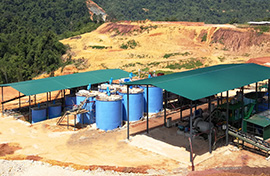-
 E-mail
guhaixin0724@gmail.com
E-mail
guhaixin0724@gmail.com
-
 Call Us
008613683147042
Call Us
008613683147042
 E-mail
guhaixin0724@gmail.com
E-mail
guhaixin0724@gmail.com
 Call Us
008613683147042
Call Us
008613683147042
2019-12-10 Views: 8045
Warm Tip: If you want to know more information, like quotation, products, solutions, etc., please Click here ,and contact us online.

CIP: gold all-slime cyanidation carbon in pulp method
CIL: gold all-slime cyanidation carbon in slurry method
CIP and CIL method is a new process for processing precious metal-containing pulp on the basis of the conventional cyanide gold extraction method.
1. Leaching and adsorption: dissolving gold from the slurry;
2. Desorption: desorb gold from the gold-loaded carbon;
3. Electrowinning: deposits gold from a pregnant.
In CIP process, leaching and adsorption are two operations, the leaching tank is used for cyanide leaching of the slurry, and the carbon slurry tank is used for adsorption of gold by activated carbon.
In CIL process, leaching and adsorption of slurry is an operation. These two steps are carried out in the same tank, so it is generally referred to as a leaching tank or a carbon slurry tank.
The CIP process is mainly consist of 7 steps.
● Preparation of leaching raw materials
● Agitation leaching
● Counter current carbon adsorption
● Desorption of gold-loaded carbon
● Electrolysis
● Smelting ingots
● Auxiliary operations for activated carbon regeneration
It is characterized by two operations, namely leaching adsorption and desorption of gold-loaded carbon, instead of leaching, washing, and clarification.
Since the gold-loaded carbon after the adsorption of gold is separated from the leaching residue (cyanide slurry), it can be carried out on a simple screening equipment, and can be washed and easily separated. It eliminates the interference of argillaceous minerals and thus has a wider adaptability to various minerals.
The leaching operation in the CIP process has the same leaching conditions as the conventional cyanidation method, and is generally leached by a continuous cyanidation method in the leaching tank, and the cyanide required for the leaching process can be added in the agitation tank.
It can be added during the grinding process, and the gold in the slurry is leached by cyanidation with activated carbon, and it is carried out in a agitation tank by air agitation or mechanical agitation. The adsorption agitation tank is often used in series.
The slurry acts from the upper section to the next section make use of its gravity, and finally is discharged by the pump. The activated carbon is loaded into each adsorption agitation tank, and the adsorption agitation tank is equipped with an interstage filter, the air lifter and so on.
In the carbon adsorption process, screens are used in many places, the purpose is to first screen out the wood and coarse ore in the slurry, often using a spacer screen or a vibrating screen.
Finally, it is the desorption of gold-loaded carbon, this operation is carried out by dissolving the gold attached to the surface of the activated carbon in a solution, and then reusing the carbon after activation.
The pregnant solution after desorption can have a gold content of up to 600 g/m3 in application. After filtering, the pregnant solution enters the electrolytic cell for electrolysis. The gold is in the form of flakes or flocs, which are deposited on the anodized titanium plate, and then scraped down to concentrate the ingot.
No. 188, Xinhai Street, high-tech Industrial Park, Fushan District, Yantai, Shandong, China.

Please leave your message here! We will send detail technical info and quotation to you!